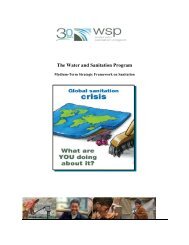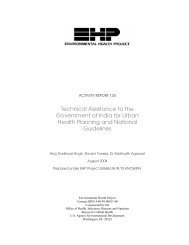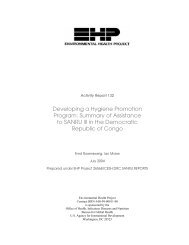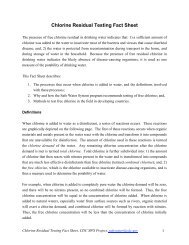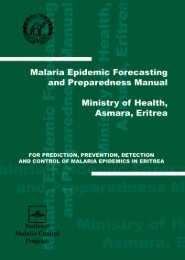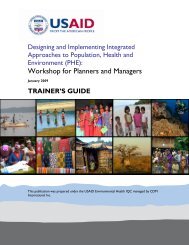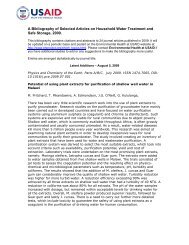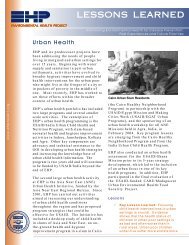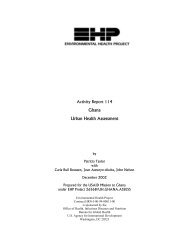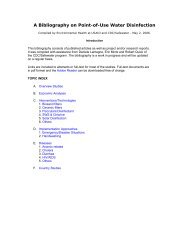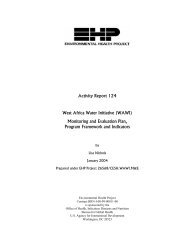Changing Glaciers and Hydrology in Asia - Environmental Health at ...
Changing Glaciers and Hydrology in Asia - Environmental Health at ...
Changing Glaciers and Hydrology in Asia - Environmental Health at ...
- No tags were found...
You also want an ePaper? Increase the reach of your titles
YUMPU automatically turns print PDFs into web optimized ePapers that Google loves.
<strong>in</strong>creased <strong>at</strong>tention to WASH <strong>in</strong>terventions, gre<strong>at</strong>er regional cooper<strong>at</strong>ion <strong>in</strong> management ofw<strong>at</strong>er resources, <strong>and</strong> improved ecosystem resilience.For new or strengthened WUAs <strong>and</strong> FUGs, co-benefits <strong>in</strong>clude local community empowerment;democr<strong>at</strong>ic practices such as elections, annual meet<strong>in</strong>gs, <strong>and</strong> publish<strong>in</strong>g decisions <strong>and</strong> budgets toits members; <strong>in</strong>tegr<strong>at</strong>ion of WASH <strong>in</strong>terventions; <strong>and</strong> gre<strong>at</strong>er <strong>in</strong>volvement of women <strong>in</strong>governance of w<strong>at</strong>er.Centers for on-farm w<strong>at</strong>er-efficient crop production can yield co-benefits <strong>in</strong> improved w<strong>at</strong>erefficiency, ma<strong>in</strong>ta<strong>in</strong>ed or improved crop yields, potential to keep farmers on the l<strong>and</strong> <strong>and</strong> reducemigr<strong>at</strong>ion, <strong>and</strong> improved food security <strong>and</strong> nutrition.Other co-benefits of programs focus<strong>in</strong>g on w<strong>at</strong>er management could <strong>in</strong>clude susta<strong>in</strong>able forestrypractices implemented, <strong>in</strong>clud<strong>in</strong>g afforest<strong>at</strong>ion <strong>and</strong> agroforestry projects, reduced illegal logg<strong>in</strong>g<strong>and</strong> forest degrad<strong>at</strong>ion, reduced greenhouse gas emissions, biodiversity enhancement,protection of w<strong>at</strong>ersheds, use of forest resources to improve livelihoods with susta<strong>in</strong>ablepractices, <strong>and</strong> prevention of forest fires <strong>and</strong> open burn<strong>in</strong>g.5.2.2 Focus on EcosystemsThe health of the mounta<strong>in</strong> ecosystems <strong>in</strong> High <strong>Asia</strong> is central to the health of the lowl<strong>and</strong>ecosystems which support the lives <strong>and</strong> livelihoods of hundreds of millions of people <strong>in</strong> theGanges <strong>and</strong> Indus w<strong>at</strong>ersheds, among others. In addition to their contributions to biodiversityconserv<strong>at</strong>ion, these mounta<strong>in</strong> ecosystems contribute directly to food security <strong>and</strong> to humanhealth. W<strong>at</strong>er from the snowpack, glaciers, <strong>and</strong> slopes of High <strong>Asia</strong> is the lifel<strong>in</strong>e for all of thesesystems, both human <strong>and</strong> n<strong>at</strong>ural.Where access to fresh w<strong>at</strong>er is already limited, changes <strong>in</strong> the quantity <strong>and</strong> quality of w<strong>at</strong>erresources will directly impact food security <strong>and</strong> human health. Human health <strong>and</strong> well-be<strong>in</strong>g are<strong>in</strong>tim<strong>at</strong>ely tied to the health of life-susta<strong>in</strong><strong>in</strong>g ecosystems, yet this complex rel<strong>at</strong>ionship is rarelytaken <strong>in</strong>to account <strong>in</strong> either ma<strong>in</strong>stream health or environment/n<strong>at</strong>ural resource managementprogramm<strong>in</strong>g.This program approach is based on the premise th<strong>at</strong> a human health sector approach alone isnot sufficient for underst<strong>and</strong><strong>in</strong>g <strong>and</strong> improv<strong>in</strong>g human health: economic, social, <strong>and</strong>environmental factors all play important roles. The ecosystem management approach to humanhealth (sometimes called the Eco<strong>Health</strong> approach) aims to build health <strong>in</strong>terventions based onthe web of ecologically based factors affect<strong>in</strong>g human health – as well as the l<strong>in</strong>ks between them.Equipped with knowledge about these l<strong>in</strong>ks, local communities can better manage ecosystems toimprove both human health <strong>and</strong> the health of the ecosystem while <strong>at</strong> the same time start<strong>in</strong>g toth<strong>in</strong>k through adapt<strong>at</strong>ion str<strong>at</strong>egies for changes <strong>in</strong>duced by clim<strong>at</strong>e change.USAID could design two types of programs to promote ecosystem <strong>in</strong>tegrity <strong>and</strong> resilience <strong>and</strong>promote human health. Although the approach is <strong>in</strong>tegr<strong>at</strong>ed <strong>in</strong> itself, the types could also beimplemented together. One type focuses on conserv<strong>in</strong>g or restor<strong>in</strong>g the n<strong>at</strong>ural processes ofdiverse ecosystems such as w<strong>at</strong>ersheds, flood pla<strong>in</strong>s, forest, <strong>and</strong> wetl<strong>and</strong>s. A second type61



